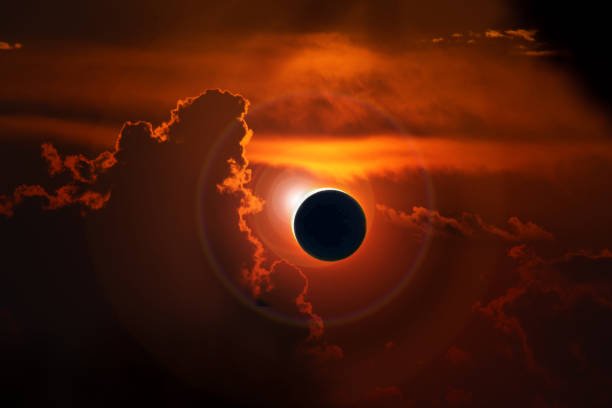Total Solar Eclipse .When and how to watch it in India
The first point of contact on mainland. North America will be the Pacific. coast of Mexico during the total solar eclipse, which is scheduled. to begin over the South Pacific Ocean.
The lunar phenomena will cause the sun to be totally obscured. by the moon.
The shadow will pass through Texas and other US states.

Indian skygazers don’t have to be excluded from the total solar eclipse Unfortunately, for astronomy aficionados in India, the complete solar. eclipse scheduled for April 8, 2024, will remain a far-off sight in an. event that would enthrall watchers across North America.
The full moon phase, during which the. sun is totally obscured by the .moon and .casts a shadow on Earth, will pass across Mexico, the US, and Canada, but it won’t be seen. from the Indian subcontinent.
The eclipse is. scheduled ..to begin over the South..Pacific Ocean, with ..Mexico’s Pacific coast serving as the first point of contact on continental North America at around. 11:07 a.m. (11:37 p.m. IST).
From then, the shadow will pass through a number.. of US states, with a little amount of visibility remaining in Tennessee and Michigan, as well as .Texas, Oklahoma, Arkansas, Missouri, Illinois, Kentucky, Indiana, Ohio, Pennsylvania, New York, Vermont, New Hampshire, and Maine.
Indian sky watchers don’t have to .feel excluded despite the geographic distance. A live feed of the eclipse will be accessible starting at 10:30 pm IST, courtesy of contemporary .technology.

For those in places like India that are not in the path of totality, this digital window provides a rare chance to virtually experience it.
The much-talked-about complete solar eclipse is a celestial display.
From then, the shadow /will pass through a number of .US states, with a little amount of visibility remaining in Tennessee and .Michigan, as well as. Texas, .Oklahoma, Arkansas, Missouri, Illinois, Kentucky, Indiana. Ohio, Pennsylvania.., New York, Vermont, .New. Hampshire, and Maine. At around.. 5:16 p.m. NDT (1:16 a.m. IST), the phenomena will, cross into Canada and pass over .areas including Southern Ontario, Quebec, New Brunswick, Prince Edward Island., and Cape .Breton before emerging over the Atlantic coast of Newfoundland.
JOHNS .HOPKINS EXPERTS .DISCUSS THE UPCOMING .TOTAL SOLAR ECLIPSE
The panelists discussed .the physics underlying what makes a total solar eclipse so unique and urged viewers to see the unusual phenomenon on April 8 up close.
The United States will witness its final complete solar eclipse until 2044 on Monday, April 8, marking the second such event in seven years. The region where the moon will totally obscure the sun as it sweeps up from Texas and heads northeast into Maine is home to more than 30 million people. It is anticipated that millions more would travel to witness totality.

On Friday, a virtual briefing including four specialists from Johns Hopkins University covered the physics of eclipses as well as what spectators should be aware of and anticipate from the forthcoming celestial event.
Ray Jayawardhana, provost.. of Johns .Hopkins University, .kicked off the discussion by. recounting his own amazing first-hand account of seeing a total solar eclipse in the Altai Mountains. of Western Mongolia in 2008—one of three total. eclipses he has seen. in person. Astrophysicist Jayawardhana, a professor. in the Department of Physics and Astronomy, views. the 2008 eclipse. as both a scientific and a spiritual event. He uses the largest telescopes available to study the diversity, origins, and evolution of .planetary systems.
A picture of the most recent eclipse in 2017 was visible over his shoulder on the wall of his office. “The dual sights of the eclipse in the sky and rituals on the ground were mesmerizing and reminded me of the deep and enduring links between the celestial and the human realms,” he added. It’s worthwhile to make the trip to see a complete solar eclipse up close and in person in all of its splendor (but be careful!). There is nothing like the genuine thing, not even a livestream or picture. The memories will endure a lifetime, but the brief complete spectacle will only last a few minutes.”
Using visual aids, Bill Blair, an ..astronomer and research professor in the.. Department of Physics and Astronomy, elucidated the mechanism of an eclipse and the reason behind.. its rarity. The moon is about 25% the .size of Earth and orbits the planet.. at a distance of about.. 240,000 miles, or around 30 Earth diameters. “There ..doesn’t have to be much.. misalignment for that shadow to just go above or below the earth ..instead of striking someplace on the earth,” Blair stated.
As part of an 11-year solar cycle in which activity waxes and wanes, Monday’s eclipse coincides with solar maximum, according to astronomer and assistant professor Meredith MacGregor of the Department of Physics and Astronomy.
The corona, or the light streaks that emanate from the moon when it totally obscures the solar disk, will be “more spectacular” and “this eclipse really special” for those who are in the line of totality (assuming there are no clouds). Sunspot visibility is also increased at this time.

The reason why potential Martians cannot witness a total eclipse is because Phobos, the moon of Mars, is too tiny and too near to completely obstruct the sun, according to planetary geophysicist Kevin Lewis, an associate professor in the Department of Earth and Planetary Sciences who works with the Mars Curiosity Rover. “It’s really special that on our planet, the sun and the moon appear exactly the same size or nearly so in the sky,” he continued. However, as our moon moves farther from us
the sun and moon seem to be precisely or almost exactly the same size in the sky,” he said. Nonetheless, “total eclipses will probably only be seen on our planet for a few hundred million more years” due to the moon’s gradual yearly movement away from us.
The “diamond ring effect,” which manifests as a brilliant burst of light resembling a diamond, should be observed if you are in a totality zone (and, once more, if the weather cooperates). (It is unsafe to see the eclipse until totality, thus it should be viewed using eclipse viewing glasses.) Additionally, Jupiter may be visible in the dark sky during totality.
How to watch the 2024 total solar eclipse
In one week, the moon will obscure the sun.

Across North America, a 115-mile-wide swath will have cloud cover during the total solar eclipse on April 8, 2024. More and longer than the one that crossed the United States in 2017, an eclipse is predicted to occur this year.
Millions of people are predicted to visit cities and towns in the moon’s shadow on Earth as a result of the cosmic event. There won’t be another complete eclipse across the continent until 2045, after all.
Despite not having front-row tickets to the great show in the sky, here’s a quick primer on how to view the eclipse this spring.
read also : https://funflipnews.com/major-baltimore-bridge-collapses-after-container/
From Kerrville, Texas to Caribou, Maine, the “path of totality,” or the narrow strip where the moon’s shadow falls on Earth, will pass across portions of fifteen states.
Over 30 million people now reside inside that path, making it easy for them to see the total solar eclipse. Millions more are anticipated to travel in anticipation of the extraordinary occurrence, causing a “eclipse boom” for the regions and towns along its route.

What will occur while there is an eclipse? A total.. solar eclipse occurs when the moon .passes directly between Earth and the sun, momentarily casting a shadow over the globe. Everything in its path ..is engulfed in darkness when the moon momentarily blocks the sun’s ..blazing disk, and the dazzling “corona” ..that exists beyond the sun’s surface turns into
Be alert for the “crown.” Total solar eclipses provide an unparalleled research opportunity for scientists studying the corona, which is Latin for “crown,” or the sun’s outer atmosphere. The reason for this is that the corona that appears during totality cannot be seen as well through telescopes on Earth or in space.
Two researchers were interviewed by The NewsHour on initiatives that they think will improve our understanding of what’s going on inside the sun’s crown during this year’s eclipse.
away from the eclipse’s path? Be at ease. There are still partial eclipses that almost everyone in North America can see. The length of time will change based on where you are. The moon’s covering of the sun decreases with distance from the path of totality, to put it briefly. NASA offers an interactive map that includes

wo academics discussed projects they intend to use this year’s eclipse to shed light on what’s going on inside the sun’s crown with The NewsHour.
https://en.wikipedia.org/wiki/Solar_eclipse_of_April_8,_2024
NASA claims that conventional sunglasses are not safe to look through, regardless lenses are.
Outside the path of the eclipse? Remain calm. In North America, almost everyone may still see partial eclipses. Depending on where you are, the length will change. In other words, the moon’s covering of the sun decreases with distance from the path of totality. NASA offers an interactive map with start and length timings. Simply fill in your zip code or city.
During their time in the eclipse limelight, local PBS stations in Maine, Vermont, New Hampshire, Indiana, and Vermont are also providing live streaming coverage.
Look up at the heavens! (Please, with precaution.) To safely see a whole or partial solar eclipse, you’ll need appropriate “eclipse glasses” or handheld solar viewers. If not, there’s a chance of severe eye damage.

Check out this article from The Conversation to learn why eye protection is necessary. Avoid buying fake glasses. To further emphasize this safety tip, NASA claims that conventional sunglasses are not safe to look through, regardless of how black their lenses are.
How to wear eclipse glasses was shown by astronomer Neil deGrasse Tyson for Miles O’Brien of the News Hour.
Overcast with a potential eclipse? Better eclipse viewing occurs under clearer sky. A day or two prior to the eclipse, make careful to check the local predictions. If there are a lot of clouds
